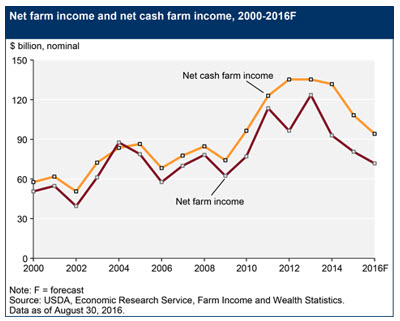WASHINGTON, Aug. 31, 2016 - Farming is expected to be even less profitable this year than it was in 2015, despite a major increase in government payments, according to a new report released Tuesday by USDA’s Economic Research Service.
The agency’s second farm finance estimate for the year paints an ugly picture. Net farm income for 2016 is now expected to total $71.5 billion. That’s better than the $54.8 billion that the agency predicted in February, but it’s still a steep drop from the $80.7 billion in 2015 and $92.6 billion in 2014.
It’s also a reason for Congress to do more to help farmers survive, National Farmers Union President Roger Johnson told Agri-Pulse.
“NFU is gravely concerned with the trend and the expected prolonged downturn in the farm economy as a whole,” Johnson said. “Family farmers and ranchers are losing their farms, and beginning farmers and ranchers are facing impassible hurdles to staying in the industry. Congress needs to act swiftly when it returns to provide short-term relief while also further developing long-term solutions to combat these increasingly difficult conditions.”
 Agriculture Secretary Tom Vilsack, however, pointed out the
upside of the report, stressing that new safety net programs in the 2014 farm
bill gave substantial assistance to producers in need.
Agriculture Secretary Tom Vilsack, however, pointed out the
upside of the report, stressing that new safety net programs in the 2014 farm
bill gave substantial assistance to producers in need.
“Farm bill program payments – including Agriculture Risk Coverage (ARC), Price Loss Coverage (PLC), and the Margin Protection Program for Dairy (MPP) – are forecast to increase nearly 25 percent to $13.5 billion in 2016,” Vilsack said in a statement. “For producers challenged by weather, disease and falling prices, we will continue to ensure the availability of a strong safety net to keep them farming or ranching.”
The cost of production for farmers has dropped significantly this year, yields and production are up, and government subsidies have increased, but prices were what hurt the most, said Jim Williamson, an economist with the Economic Research Service’s Resource and Rural Economics Division.
With the exception of some small gains for rye, hay, cotton, sugarcane, sugar beets, potatoes and a couple of other crops, cash receipts – the cash income farmers get from crop and animal sales – are forecast down for 2016. Cash receipts for this year for crops, livestock and animal products are now expected to total just $353 billion, a 7 percent drop from $379 billion last year and down from $424 billion in 2014.
Six months ago, in the ERS’s February forecast, government economists were expecting cash receipts to be about $368 billion, but new data on commodity prices, planting and production forced that prediction down by roughly $15 billion.
“The decline reflects falling commodity prices, an effect only partially offset by an increase in production,” the report concluded.
“Ask a farmer if he’s paying too much for inputs and he’ll always tell you yes, but the main driver for this drop in income is really coming from the revenue side,” said Bob Young, the chief economist for the American Farm Bureau Federation.
Input costs such as fuel are lower, though, and that’s helped farmers deal with lower prices, the ERS report said.
Total expenses for farmers this year are expected to reach about $349 billion, a roughly 3 percent decrease from $359 billion last year.
“After reaching record highs exceeding $390 billion in 2014, farm production expenses are forecast to dip for the second consecutive year in 2016,” the report said. “The forecast decline in production expenses is predominantly driven by less spending on livestock/poultry purchases, fertilizer, and fuel, which should more than offset the increased outlays for hired labor and property taxes (and) fees.”
#30
For more news, go to: www.Agri-Pulse.com

